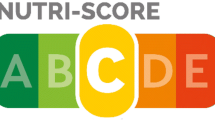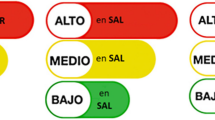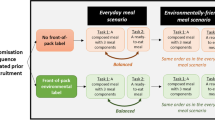Abstract
This study examines how environment-related food labels affect shopping behaviour. Using an experimental store consisting of nearly 300 available food items, we observe the food purchases of consumers before and after each product is tagged with one of three environmental labels: single traffic lights, multiple traffic lights and the kilometric format. The kilometric format indicates the greenhouse gas emissions for each product by indicating the equivalent number of kilometres driven by an average car. The other two formats are based on the traffic-light rating system used for nutrients by the British Food Standard Agency. Multiple traffic lights present three traffic lights simultaneously: one each for greenhouse gas emissions, water eutrophication and air acidity. The single traffic light label displays one unique traffic light for greenhouse gas emissions. All three types of environmental labels lead consumers to purchase more environmentally friendly food baskets (i.e., significant decreases in carbon dioxide, nitrogen and sulfur dioxide emissions). Labelling, however, does not affect the price of selected food baskets (in Euros per 100 g) or their nutritional content. By generating more product substitutions between unlabelled and labelled baskets, multiple traffic lights are more effective in reducing GHG emissions, eutrophication and acidification.


Similar content being viewed by others
Notes
See the report from the French National Assembly on environmental labelling (http://www.assemblee-nationale.fr/14/rap-info/i1562.asp, 2013).
See the report from the French Environment & Energy Management Agency on the “Life cycle assessments of agricultural products” (2008).
The Su-Vi-Max project was led by the French National Institute of Health and Medical Research in 2006.
Although sTL presents a slighlty lower mean than does KM (− 41 g vs. − 48 g), sTL is significantly different from the control group. This counter-intuitive result is explained by a much larger spread in KM groups: The standard deviations of individual meat GHG differences between the reference and labelling baskets are 133 and 180 for sTL and mTL respectively.
Although during the instructions, participants were informed orally that the laboratory was equipped with a refrigerator and freezer.
References
Argo JJ, Main KJ (2004) Meta-analyses of the effectiveness of warning labels. J Public Policy Mark 23(2):193–208
Auger P, Devinney T (2007) Do what consumers say matter? The misalignment of preferences with unconstrained ethical intentions. J Bus Ethics 76(4):361–383
Auger P, Burke P, Devinney T, Louviere J (2003) What will consumers pay for social product features? J Bus Ethics 42(3):281–304
Balcombe K, Fraser I, Di Falco S (2010) Traffic lights and food choice: a choice experiment examining the relationship between nutritional food labels and price. Food Policy 35(3):211–220
Berners-Lee M, Hoolohan C, Cammack H, Hewitt C (2012) The relative greenhouse gas impacts of realistic dietary choices. Energy policy 43:184–190
Bougherara D, Combris P (2009) Eco-labelled food products: what are consumers paying for? Eur Revue Agric Econ 36(3):321–341
Carlsson-Kanyama Annika (1998) Climate change and dietary choices—how can emissions of greenhouse gases from food consumption be reduced? Food Policy 23(3):277–293
Carlsson-Kanyama A, Gonzalez AD (2009) Potential contributions of food consumption patterns to climate change. Am J Clin Nutr 89(suppl):1704S–1709S
Cox EP III, Wogalter MS, Stokes SL, Tipton Murff EJ (1997) Do product warnings increase safe behavior? A meta-analysis. J Public Policy Mark 16(2):195–204
Darmon N, Vieux F, Maillot M, Volatier JL, Martin A (2009) Nutrient profiles discriminate foods according to their contribution to nutritionally adequate diets: a validation study using linear programming and the SAIN, LIM system. Am J Clin Nutr 89(4):1227–1236
Drewnowski A, Rehm CD, Martin A, Verger EO, Voinnesson M, Imbert P (2015) Energy and nutrient density of foods in relation to their carbon footprint. Am J Clin Nutr 101(1):184–191
Ernst &Young (2010) Product carbon Footprinting—a study on methodologies and initiatives. European Commission DG Environment
Eurobarometer S (2009) Europeans’ attitudes towards climate change. European Comm 29:30
Gadema Z, Oglethorpe D (2011) The use and usefulness of carbon labelling food: a policy perspective from a survey of UK supermarket shoppers. Food Policy 36(6):815–822
Gallastegui I (2002) The use of eco-labels: a review of the literature. Eur Environ 12:316–331
Hartikainen H, Roininen T, Katajajuuri J, Pulkkinen H (2014) Finnish consumer perceptions of carbon footprints and carbon labelling of food products. J Clean Prod 73:285–293
Hertwich E, van der Voet E, Suh S, Tukker A, Huijbregts M, Kazmierczyk P, Lenzen M, McNeely J, Moriguchi Y (2010) Environmental impacts of consumption and production: priority products and materials. International Panel on the Sustainable Use of Natural Resources, UNEP, Paris
Hieke S, Taylor CR (2012) A critical review of the literature on nutritional labeling. J Consum Aff 46(1):120–156
Janssen M, Hamm U (2012) Product labelling in the market for organic food: consumer preferences and willingness-to-pay for different organic certification logos. Food Qual Prefer 25(1):9–22
Johnston RJ, Wessells CR, Donath H, Asche F (2001) Measuring consumer preferences for ecolabeled seafood: an international comparison. J Agric Resour Econ 26(1):20–39
Maillot M, Drewnowski A, Vieux F, Darmon N (2011) Quantifying the contribution of foods with unfavourable nutrient profiles to nutritionally adequate diets. Br J Nutr 105:1133–1137
Manfredi S, Allacker K, Chomkhamsri K, Pelletier N, Maia de Souza D (2012) Product environmental footprint (PEF) guide. European Commission, Ispra
Marette S, Messean A, Millet G (2012) Consumers’ willingness to pay for eco-friendly apples under different labels: evidences from a lab experiment. Food Policy 37(2):151–161
Masset G, Soler L-G, Vieux F, Darmon N (2014) Identifying sustainable foods: the relationship between environmental impact, nutritional quality, and prices of foods representative of the french diet. J Acad Nutr Diet 114(6):862–869
Moser R, Raffaelli R (2012) Consumer preferences for sustainable production methods in apple purchasing behaviour: a non-hypothetical choice experiment. Int J Consum Stud 36(2):141–148
Muller L, Prevost M (2016) What cognitive sciences have to say about the impacts of nutritional labelling formats. J Econ Psychol 55:17–29
Muller L, Ruffieux B (2018) Shopper’s behavioural responses to ‘front-of-pack’ nutrition logo formats: GDA Diet-Logo vs. 6 alternative Choice-Logos. WP GAEL
Notarnicola B, Tassielli G, Renzulli P, Castellani V, Sala S (2017) Environmental impacts of food consumption in Europe. J Clean Prod 140:753–765
Onyango B, William H, Bellows A (2007) Purchasing organic food in US food systems: a study of attitudes and practice. Br Food J 109(5):399–411
Reijnders L, Soret S (2003) Quantification of the environmental impact of different dietary protein choices. Am J Clin Nutr 78:664S–668S
Rokka J, Uusitalo L (2008) Preference for green packaging in consumer product choices–do consumers care? Int J Consum Stud 32(5):516–525
Savage L (1954) The foundations of statistics. Wiley, New York
Sirieix L, Delanchy M, Remaud H, Zepeda L, Gurviez P (2013) Consumers’ perceptions of individual and combined sustainable food labels: a UK pilot investigation. Int J Consum Stud 37(2):143–151
Stehfest E, Bouwman L, van Vuuren D, den Elzen M, Eickhout B, Kabat P, Vuuren D, Elzen M (2009) Climate benefits of changing diet. Clim Change 95:83–102
Sutherland L, Kaley L, Fischer L (2010) Guiding Stars: the effect of a nutrition navigation program on consumer purchases at the supermarket. Am J Clin Nutr 91(4):1090S–1094S
Tagbata D, Sirieix L (2008) Measuring consumer’s willingness to pay for organic and Fair Trade products. Int J Consum Stud 32(5):479–490
Temple Norman J, Fraser Joy (2014) Food labels: a critical assessment. Nutrition 30(3):257–260
van Dooren C, Marinussen M, Blonk H, Aiking H, Vellinga P (2014) Exploring dietary guidelines based on ecological and nutritional values: a comparison of six dietary patterns. Food Policy 44:36–46
van Herpen E, van Trijp HCM (2011) Front-of-pack nutrition labels. Their effect on attention and choices when consumers have varying goals and time constraints. Appetite 57(1):148–160
Van Loo EJ, Caputo V, Nayga R, Meullenet J, Ricke S (2011) Consumers’ willingness to pay for organic chicken breast: evidence from choice experiment. Food Qual Prefer 22(7):603–613
Vanclay J, Shortiss J, Aulsebrook S, Gillespie A, Howell B, Johanni R, Maher M, Mitchell K, Stewart M, Yates J (2011) Customer response to carbon labelling of groceries. J Consum Policy 34(1):153–160
Vermeulen S, Campbell B, Ingram J (2012) climate change and food systems. Annu Rev Environ Resour 37(1):195–222
Vlaeminck P, Jiang T, Vranken L (2014) Food labelling and eco-friendly consumption: experimental evidence from a Belgian supermarket. Ecol Econ 108:180–190
Wickramasinghe K, Scarborough P, Goldacre M, Rayner M (2013) Defining sustainable diets by comparing greenhouse gas emissions from different food groups: a systematic review. Lancet 382(Supplement 3):S104
Wier M, Calverley C (2002) market potential for organic foods in Europe. Br Food J 104(1):45–62
Zizzo DJ (2010) Experimenter demand effects in economic experiments. Exp Econ 13(1):75–98
Author information
Authors and Affiliations
Corresponding author
Additional information
Publisher's Note
Springer Nature remains neutral with regard to jurisdictional claims in published maps and institutional affiliations.
Appendices
Appendix 1: Instructions
Instructions were projected both on a big screen and on each individual computer screen and read aloud by a facilitator. The following text corresponds to the KM treatment.
Welcome to this experiment conducted by the Grenoble Applied Economics Laboratory of the University of Grenoble-Alpes and the French National Institute of Agricultural Research. This experiment focuses on food consumption behaviours. Instructions will be given to you as the experiment unfolds.
During the experiment, you will have to make decisions. If you have any difficulties in understanding, please do not hesitate to contact us with any questions you may have.
In front of you is an envelope containing 35€ corresponding to the compensation for your participation.
You will have the opportunity to buy some products. Regarding these products you will have to buy, it is important that you understand clearly, before we begin, why you will have to make some purchases and how you will do it.
You will actually buy some products at the end of this experience. The purpose of these purchases is to ensure that we are observing your true buying behaviour and not just “buying intentions”. As behavioural scientists, we know that a purchase intention may be different from an actual purchase. Our principle is simple: motivate you to make real purchases (almost) as if you were shopping.
In the coming experience, each of you will have to make many purchasing choices. Some of these choices will lead to real purchases. You will leave later with some products, all from the choices you have made, that you will have bought with your own money. Under no circumstances does our laboratory make a profit on sales. The (few) products sold will be sold at supermarket selling prices. You will discover these prices during the experience.
Organization of the session
This experience is composed of several parts. Instructions will be given before each part. In two parts, your task will be to compose food baskets.
The data collected are confidential and will only be used for scientific purposes. No individual data will be accessible. The results will be disseminated and published in a statistical mode. The anonymity of each individual will thus be respected.
PART 1
Your task
During this first part, your task is to buy food for your household for 2 days. You will have to compose a basket as you would in a grocery store. In order to observe real buying behaviour, your decisions will be incentivized (i.e., you will buy certain products from your baskets at the end of the experiment).
As in a real store, you are free to buy what and how much you like. If you are not satisfied with the products in this store or if you are sufficiently supplied at home, you are not obliged to buy! The following products are assumed to be available to you at home and should therefore not be purchased here: Butter—flour—oil—spices—coffee—tea—condiments—water—alcohol—wine—sugar—vinegar—sauces.
Your basket
To compose your basket, you can choose from 282 food products. These products are presented in the catalogue that is placed in front of you. Each page of the catalogue is related to a product category. (A summary is on the first page). Each category contains 6 or 9 products.
A barcode reader is at your disposal in front of you. To select a product, scan the product’s barcode and press the button. The product will then appear on your screen.
The products
Pictures represent the front side of the packaging as presented on the shelves of a supermarket. By clicking on it on your computer screen, you can enlarge it.
The posted price corresponds to the prices observed in a local supermarket. Weight and price per kilo are provided.
When a product is selected on the screen, you can click on the ‘Details tab’. You will then access an information page that provides access to three sets of information: Ingredients, Nutritional information, Environmental information (NOTE: these three sets of information are described in detail with some examples).
Your purchases
To ensure that your behaviours today best match your actual behaviours, your decisions will be incentivized. This part or the next, depending on a draw at the end of the experiment, will be considered for actual purchases.
We will use the following terms and conditions:
In the room behind you are 71 products chosen from the 282 in the catalogue. 1/4 of the products in the catalogue are available. You will not know what these products are.
At the end of the experiment, we will identify the products in your shopping cart that are available here: probably 1/4 of your products.
Only one part will be taken into consideration for real purchase. If this part is drawn (1 chance over 2), you will have to buy these few products. For example, if your basket includes 20 products, you will have to buy 4 or 5 of them, which is an expense of a few Euros. You will leave with these products. Please note that the products are sold at the same selling prices as in a store.
In order to familiarize participants with the computer interface, screenshots are projected and described.
PART 2
Your Task
We now ask you to compose another shopping cart, an alternative to your first phase shopping cart. A modified catalogue is distributed to you. It contains the same products as the previous one, in the same provision. A label is now associated with each product.
Incentives
This part is an alternative to the first phase. Only one part will be considered for the sale of the products at the end of the experiment. This one will be randomly drawn.
(NOTE: Part 2 instructions end here for the control groups. For the three treatment groups, the corresponding labelling is described)
Description of the labelling
(KM TREATMENT)
Each product now has a label. Such labelling may appear on the front of the product’s packaging, if the public authorities so decide. This labelling is an indicator of environmental quality. It concerns the impact on climate change, measured by greenhouse gas emissions, measured in carbon dioxide (CO2) equivalent. To build the indicator, greenhouse gas emissions were assessed at all stages of the product’s life cycle (Life Cycle Assessment or LCA): agricultural production, transport, processing, packaging, etc.
In the catalogue, to get a concrete idea of this impact, we use an equivalence. When we drive a car, the engine emits greenhouse gases. The greenhouse gas impact of a food is indicated in kilometer equivalents. For example, if a liter of whole milk is indicated as 11.0 km, this means that, to produce, package and transport this litre of milk, the emissions are equivalent to what a motor car emits when it travels 11 kilometres.
(sTL TREATMENT)
Each product now has a label. Such labelling may appear on the front of the product’s packaging, if the public authorities so decide. This labelling is an environmental impact indicator. It concerns the impact on climate change, measured by greenhouse gas emissions, measured in carbon dioxide (CO2) equivalent. The products in each category are classified into three groups: One-third of the best products in terms of the environment have a green dot; One third of the worst environmental performers have a red dot; The intermediate third has a yellow dot.
(mTL TREATMENT)
Each product now has a label. Such labelling may appear on the front of the product’s packaging, if the public authorities so decide. This labelling is an environmental impact indicator. It includes 3 colored dots. Each dot informs about an impact. Respectively: On climate change (which is measured in carbon dioxide emission equivalents); On water pollution (phosphate); On air pollution (sulphur dioxide).
For each environmental impact (climate change, water pollution and air pollution) the dot is: Green if the product is in the top third of the category (page); Red if the product is in the lowest third of the category (page); Yellow if the product is in the intermediate third of the category (page).
Appendix 2: France and Grenoble sociodemographic table
France | Grenoble | |
|---|---|---|
Household size, number of persons | 2.3 | 2.3 |
Income, € per months and per consumption unit | 1606€ | 1558€ |
Education, % | ||
No high school diploma | 21.6% | 26.4% |
High school diploma | 17.7% | 15.3% |
BA | 39.4% | 36.3% |
Master and above | 21.6% | 22.2% |
Rights and permissions
About this article
Cite this article
Muller, L., Lacroix, A. & Ruffieux, B. Environmental Labelling and Consumption Changes: A Food Choice Experiment. Environ Resource Econ 73, 871–897 (2019). https://doi.org/10.1007/s10640-019-00328-9
Accepted:
Published:
Issue Date:
DOI: https://doi.org/10.1007/s10640-019-00328-9




